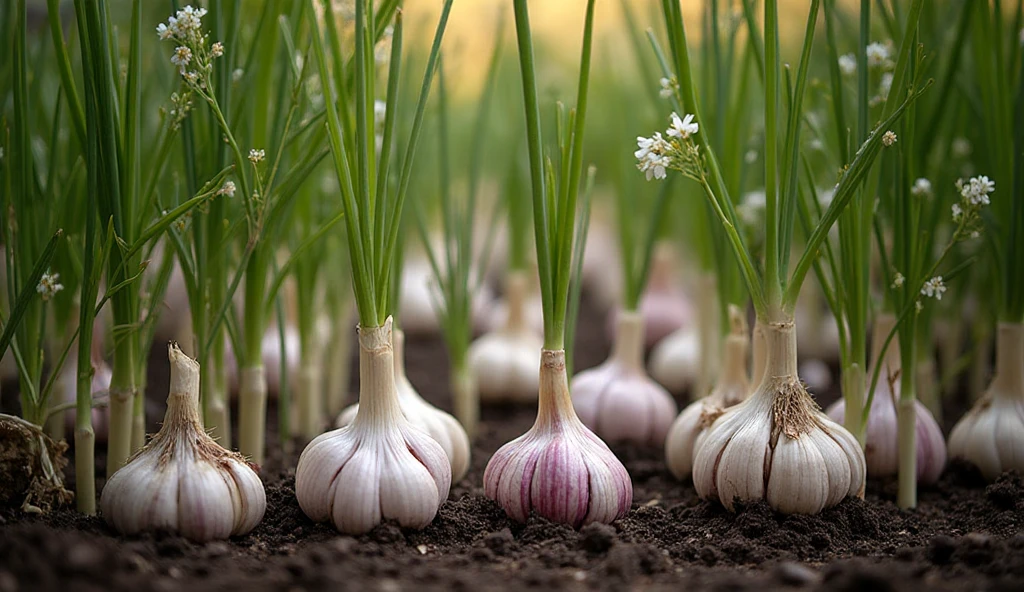Garlic is one of the most popular and versatile plants to grow at home. It not only enhances the flavor of countless dishes but also offers many health benefits. Learning how to grow garlic successfully can save you money and give you fresh, organic garlic whenever you need it. This article will guide you through the entire process—from choosing the right garlic variety to harvesting your bulbs.
For a detailed understanding of garlic’s nutritional benefits and uses, check out the National Institutes of Health’s garlic fact sheet.
Understanding How to Grow Garlic and Why It’s Worth It
Growing garlic is surprisingly simple, but it requires a bit of attention to soil, planting time, and care. Garlic thrives in well-drained soil with good organic matter, and it needs full sunlight for optimal growth. If you want to know more about soil preparation and the science behind garlic growth, the Royal Horticultural Society’s garlic growing guide provides excellent advice.
Gardening enthusiasts appreciate garlic because it’s low maintenance, pest-resistant, and rewarding. Moreover, knowing how to grow garlic at home allows you to avoid chemicals often found in commercially grown bulbs.
Preparing the Best Soil for Garlic Growth
Successful garlic cultivation starts with soil. Garlic prefers loamy, well-drained soil with a pH between 6.0 and 7.5. The right soil ensures the garlic bulb develops fully underground. Incorporating compost or well-rotted manure enriches the soil, promoting healthy root and bulb formation.
For guidance on soil testing and improvement, you can refer to the USDA’s soil management resources.
When and How to Plant Garlic for Optimal Growth
Planting garlic at the right time is crucial. Most gardeners plant garlic in the fall, about 4-6 weeks before the ground freezes. This allows the cloves to develop roots but prevents premature sprouting. If you live in a mild climate, garlic can also be planted in early spring.
Each garlic bulb is made of multiple cloves. You separate these cloves and plant them pointed side up, about 2 inches deep and 4-6 inches apart. For a detailed planting calendar and tips, the University of Minnesota Extension’s garlic planting guide is a great resource.
Choosing the Right Garlic Variety for Your Climate
There are two main types of garlic: hardneck and softneck. Hardneck garlic grows better in colder climates and produces a flower stalk called a scape, which you can harvest for extra flavor. Softneck garlic is better suited for warmer climates and stores longer.
Deciding which type to grow depends on your local weather and your culinary preferences. For a variety guide, check out the National Gardening Association’s garlic varieties page.
How to Care for Garlic: Watering, Fertilizing, and Sunlight
Garlic needs consistent watering, especially during bulb formation. However, overwatering can cause rot, so the soil should be moist but not waterlogged. Garlic grows best in full sunlight, requiring at least six hours a day.
Fertilizing with nitrogen-rich compost or organic fertilizer encourages leafy growth early on. Once the bulbs start forming, reducing nitrogen can help the bulbs mature properly.
For detailed care tips, the Colorado State University Extension’s garlic care page offers excellent advice.
Organic Garlic Growing: Avoiding Chemicals for Healthier Harvests
Organic gardening enthusiasts often ask how to grow garlic without synthetic fertilizers or pesticides. Garlic is naturally pest-resistant due to its strong aroma, making it easier to grow organically. Crop rotation and companion planting with herbs like chamomile can help reduce disease risks.
For more on organic garlic growing methods, the Rodale Institute’s organic gardening resources are very informative.
Common Garlic Diseases and Pests to Watch Out For
Despite its resilience, garlic can still fall victim to fungal diseases like white rot and pests like onion thrips. Proper soil drainage and crop rotation are essential to avoid buildup of soil pathogens. Using disease-free planting stock is also vital.
If you want to learn more about identifying and managing garlic diseases, the Penn State Extension on garlic diseases is a trusted resource.
When and How to Harvest Garlic for the Best Flavor and Storage
Garlic is usually ready to harvest in mid to late summer when the leaves start turning yellow but are still mostly green. This timing ensures the bulbs are mature but not overripe. After pulling the bulbs, allow them to cure in a dry, shaded, and well-ventilated place for several weeks.
Proper curing improves storage life and flavor. For a step-by-step harvest guide, check out The Old Farmer’s Almanac’s garlic harvesting tips.
FAQs About Growing Garlic
What is the best time of year to plant garlic?
Typically, garlic is planted in the fall before the first frost, allowing roots to develop during the cold months. However, spring planting is possible in milder climates.
How long does it take for garlic to grow?
Garlic usually takes 6-8 months from planting to harvest. Fall-planted garlic is harvested the following summer.
Can garlic be grown indoors?
Yes, garlic can be grown indoors in pots if provided with enough sunlight and proper soil conditions.
How often should garlic be watered?
Garlic prefers moist soil but not soggy. Water consistently, especially during bulb development.
What soil pH is ideal for garlic?
Garlic grows best in slightly acidic to neutral soil with a pH between 6.0 and 7.5.
Conclusion: Start Growing Garlic Today for a Fresh, Flavorful Harvest
Knowing how to grow garlic empowers gardeners to enjoy fresh, flavorful, and organic garlic straight from their garden. From selecting the right variety and soil to proper planting, care, and harvesting, garlic cultivation is a rewarding experience. Whether you’re a beginner or an experienced gardener, these tips will help you produce healthy bulbs for your kitchen and beyond.
For more gardening inspiration and to explore growing other herbs and vegetables, visit The Royal Horticultural Society.
